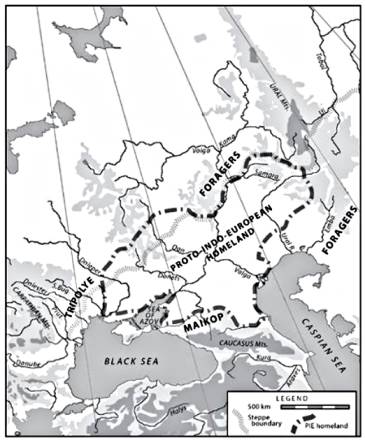The Horse, The Wheel, and Language
David Anthony
[A] substantial vocabulary list has been reconstructed for one of the languages spoken about five thousand years ago. That language is the ancestor of modern English as well as many other modern and ancient languages. All the languages that are descended from this same mother tongue belong to one family, that of the Indo-European languages. Today Indo-European languages are spoken by about three billion people—more than speak the languages of any other language family...
This book argues that it is now possible to solve the central puzzle surrounding Proto- Indo-European, namely, who spoke it, where was it spoken, and when. Generations of archaeologists and linguists have argued bitterly about the “homeland” question...
[A British judge, Jones' 1700s] arrival in Calcutta, a mythically alien place for an Englishman of his age, was the opening move in the imposition of royal government over a vital yet irresponsible merchant’s colony. Jones was to regulate both the excesses of the English merchants and the rights and duties of the Indians. But although the English merchants at least recognized his legal authority, the Indians obeyed an already functioning and ancient system of Hindu law, which was regularly cited in court by Hindu legal scholars, or pandits (the source of our term pundit). English judges could not determine if the laws the pandits cited really existed. Sanskrit was the ancient language of the Hindu legal texts, like Latin was for English law. If the two legal systems were to be integrated, one of the new Supreme Court justices had to learn Sanskrit. That was Jones...
As Jones pored over Sanskrit texts his mind made comparisons not just with Persian and English but also with Latin and Greek, the mainstays of an eighteenth-century university education; with Gothic, the oldest literary form of German, which he had also learned; and with Welsh, a Celtic tongue and his boyhood language which he had not forgotten..
Jones came to a startling conclusion, announced in his third annual discourse to the Asiatic Society of Bengal, which he had founded when he first arrived. The key sentence is now quoted in every introductory textbook of historical linguistics (punctuation mine):
The Sanskrit language, whatever be its antiquity, is of a wonderful structure: more perfect than the Greek, more copious than the Latin, and more exquisitely refined than either; yet bearing to both of them a stronger affinity, both in the roots of verbs and in the forms of grammar, than could possibly have been produced by accident; so strong indeed, that no philologer could examine them all three, without believing them to have sprung from some common source, which, perhaps, no longer exists.
Jones had concluded that the Sanskrit language originated from the same source as Greek and Latin, the classical languages of European civilization...
The Indo-European homeland is like the Lost Dutchman’s Mine, a legend of the American West, discovered almost everywhere but confirmed nowhere. Anyone who claims to know its real location is thought to be just a little odd—or worse. Indo-European homelands have been identified in India, Pakistan, the Himalayas, the Altai Mountains, Kazakhstan, Russia, Ukraine, the Balkans, Turkey, Armenia, the North Caucasus, Syria/Lebanon, Germany, Scandinavia, the North Pole, and (of course) Atlantis. Some homelands seem to have been advanced just to provide a historical precedent for nationalist or racist claims to privileges and territory. Others are enthusiastically zany. The debate, alternately dryly academic, comically absurd, and brutally political, has continued for almost two hundred years.
This chapter lays out the linguistic evidence for the location of the Proto-Indo-European homeland. The evidence will take us down a well-worn path to a familiar destination: the grasslands north of the Black and Caspian Seas in what is today Ukraine and southern Russia, also known as the Pontic-Caspian steppes..
Knowing that we are looking for a society with a specific list of material culture items and institutionalized power distinctions is a great help in locating the Proto-Indo-European homeland. We can exclude all regions where hunter-gatherer economies survived up to 2500 BCE. That eliminates the northern forest zone of Eurasia and the Kazakh steppes east of the Ural Mountains. The absence of honeybees east of the Urals eliminates any part of Siberia. The temperate-zone flora and fauna in the reconstructed vocabulary, and the absence of shared roots for Mediterranean or tropical flora and fauna, eliminate the tropics, the Mediterranean, and the Near East. Proto-Indo- European exhibits some very ancient links with the Uralic languages, overlaid by more recent lexical borrowings into Proto-Uralic from Proto-Indo-European; and it exhibits less clear linkages to some Pre—or Proto-Kartvelian language of the Caucasus region. All these requirements would be met by a Proto-Indo-European homeland placed west of the Ural Mountains, between the Urals and the Caucasus, in the steppes of eastern Ukraine and Russia.

Fire-resistant clay pots made it possible to cook stews and soups all day over a low fire, breaking down complex starches and proteins so that they were easier to digest for people with delicate stomachs—babies and elders. Soups that simmered in clay pots helped infants survive and kept old people alive longer.